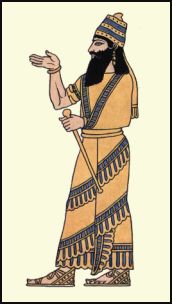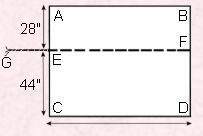By Pauline Weston Thomas for Fashion-Era.com
- Early Assyria
- Ancient Egyptian and Assyrian Dye Colours
- Simple Draped Assyrian Costume
- Clothing of an Assyrian Attendant to a King c1000 B.C.
- The Shawl Patterns
- King Assur-nasir-pal
- King Assur-nasir-pal's draped Shawl Pattern Guideline
- Version P
- Female Assyrian Dress & of a Queen
- The Hunter
Early Assyria
Egyptians were geographically close to the other great civilisations of the ancient world, including Iraq an area once known as Mesopotamia. The Greek term Mesopotamia meant 'land between Rivers', i.e. land between the river Tigris and river Euphrates, rivers often mentioned in the Holy Bible.
Thousands of years ago, Assyrian life extended into several countries. Assyria covered part of not only Turkey, but also part of Syria, part of Iran and part of north Mesopotamia (now Iraq). Today the Assyrian people are in a struggle for survival. Genocide, emigration, absorption into other societies as well as loss of ancestral lands, have all contributed to the demise of the people.
Assyria was an important civilisation that emerged between 5000 B.C. and 2400 B.C. By the time of the dynasties of the Old Kingdom of Egypt in 2400 B.C., Assyria was also reaching its first golden age which would last for another 3000 years. The Assyrian Kingdom went into decline after 612.B.C for 645 years and then there was a second golden age for 1000 years from 33 A.D. to 1300 A.D. This latter period included the Byzantine era.
Ancient Egyptian and Assyrian Dye Colours
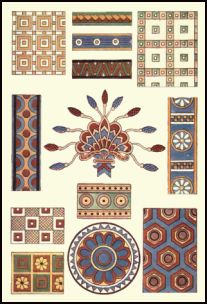
Typical Ancient Egyptian and Assyrian Dye Colours included blue, red, yellow, green and purple.
Blue - a dark indigo. You will be aware indigo fades so it was sometimes paler blue.
Red - similar to Indian red.
Yellow - similar to yellow ochre.
Green - similar to green bice - a dull yellow green.
Purple - a dark purple with a brownish (aubergine like) tone.
These colours were from natural products and could be used to dye fabrics. Often they were used as the surface decorative threads of embroidery, or in weaving patterns.
The pattern formations were repetitive and grid like, similar to these shown on the costume plate featuring Assyrian ornament.
 The central image in the decorative ornament plate is of the Sacred Tree. The other patterns are all over patterns for costumes or are repeat border patterns. I find this plate fascinating since it reminds me of an almost identically coloured tile pattern in the hallway of my mother's Edwardian house.
The central image in the decorative ornament plate is of the Sacred Tree. The other patterns are all over patterns for costumes or are repeat border patterns. I find this plate fascinating since it reminds me of an almost identically coloured tile pattern in the hallway of my mother's Edwardian house.
Notice too how the colours are very similar to those in the Egyptian plate left and shown fuller sized on an earlier page.
Simple Draped Assyrian Costume
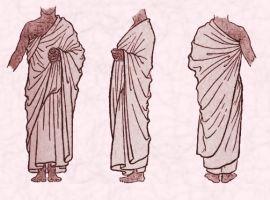 The costume history plates of Assyria show how Assyrian clothing consisted of two simple styles - the shawl and the tunic. These two styles were worn alone, or in combination and changes were introduced by varying the proportions of the tunic or shawl. The simple shawl shown right, was dependant on how the wearer wrapped it and the drapery is circa 2500 B.C. after the figure of King Gudea at the British Museum.
The costume history plates of Assyria show how Assyrian clothing consisted of two simple styles - the shawl and the tunic. These two styles were worn alone, or in combination and changes were introduced by varying the proportions of the tunic or shawl. The simple shawl shown right, was dependant on how the wearer wrapped it and the drapery is circa 2500 B.C. after the figure of King Gudea at the British Museum.
Many of the styles illustrated here are suitable for costumes to wear in religious plays and pageants. This first shawl pattern uses a length of fabric to create Assyrian Style A of King Gudea below right. The measurements are 56" by 118".
- To wrap this style place corner B under the left armpit and draw edge B to A around the back shoulder under the right armpit.
- Next take the drape across the front of the chest and around the back again and under the right arm pit yet again.
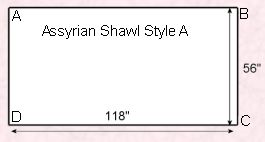 Now throw edge B to A upwards across the chest and over the left shoulder so that corner A hangs down the back.
Now throw edge B to A upwards across the chest and over the left shoulder so that corner A hangs down the back.- Finally take corner A and tuck it in at the right side breast. Unless you choose to raise the left arm, it remains totally covered by the drapery.
This fabric arrangement gives a similar appearance to that of the Roman Toga of a much later era.
The earliest styles of all were plain linen or wool fabrics, but most later examples of Assyrian costume had lavish decorative embellishment to the base material. The clothing of an Assyrian king would have been covered in several types of ornamentation, including embroidered patterns, fringes, woven pattern and gem encrustation, plus jewellery accessories.
For hunting and military purposes, metal, skins and furs of animals were also used for Assyrian clothing. Biblical references suggest that rich colours were usual on the costume of the day and these colours were similar to those used in Egypt.
Clothing of an Assyrian Attendant to a King c1000 B.C.
Below left - The second Assyrian costume is that of the type worn by an attendant to a king such as King Assur-nasir-pal, shown further below. The Assyrian costume consists of a simple to the knee tunic with sleeves. The outfit is made complete with 2 decorative shawls wrapped into position over the tunic.
The Shawl Patterns
To make this costume shape, follow these instructions using the two shawl patterns below.
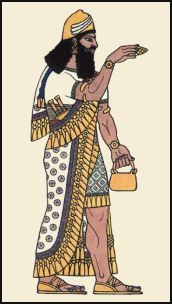 1. TAKE THE SMALL SHAWL IN YOUR HANDS - 20" X 40".
1. TAKE THE SMALL SHAWL IN YOUR HANDS - 20" X 40".
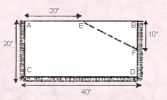 Begin with point A of the SMALL shawl placed on the right hip. Use edge A to B of the shawl and wrap it around the abdomen front toward the left side and fully around the waist.
Begin with point A of the SMALL shawl placed on the right hip. Use edge A to B of the shawl and wrap it around the abdomen front toward the left side and fully around the waist.
The excess fabric created IN THE SMALL SHAWL by B-E-F can be tucked in at the waistline.
This is all covered by a wide leather (tan) belt, which is held in position by a narrow leather contrast (red) belt.
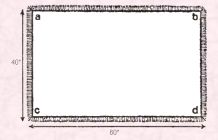 2. TAKE THE LARGER SHAWL - 40" X 60"
2. TAKE THE LARGER SHAWL - 40" X 60"
Tuck end B of the larger shawl into the narrow belt on the left side of the waist.
The edge A to B of the large shawl is passed around the back towards the right side of the waist, upwards towards the chest. It then hangs down the back over the shoulder. This completes the drapery of the costume.
King Assur-nasir-pal
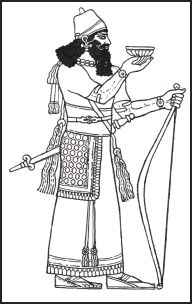 Left - King Assur-nasir-pal wears a similar outfit to his attendant above, but his tunic is longer to the ankle. Historians suggest he most probably reigned between 883 and 858 B.C.
Left - King Assur-nasir-pal wears a similar outfit to his attendant above, but his tunic is longer to the ankle. Historians suggest he most probably reigned between 883 and 858 B.C.
A tasselled small 20" square shawl has been tied around his waist to add decorative value to his outfit. More tassels hang from his necklace and also from his sword belt. The tassels seem wiry which may mean they were made from horsehair.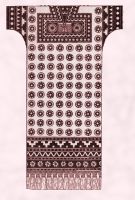
King Assur-nasir-pal's cap is similar to a Fez or tarbush.
This richly embroidered tunic shown right is one King Assur-nasir-pal might have worn. The hem has a decorative fringe and the tunic would have been pulled in at the waist with a wide and narrow belt.
The neck opening is a slit but the neckline also has buttons on the shoulder line.
The tunic is typical of Assyrian clothing of the ninth century B.C. and is quite similar to the foundation Egyptian tunic.
You can see pattern guidelines for the Egyptian tunic here. For fancy dress purposes a full length T-Shirt bed shirt might make a satisfactory base for your costume once adorned with fringed shawls.
You are reading a costume history article by Pauline Weston Thomas at www.fashion-era.com ©
King Assur-nasir-pal's draped Shawl Pattern Guideline
This is another representation of the Assyrian King Assur-nasir-pal. The best way to understand how the drapery is assembled is to observe the stages below right.
Over the long tunic above right, the king would have worn a shawl drapery. The shawl would have measured 72" X 90".
To drape this shawl, line E to F would have been folded over so that A to B hangs on the outside of the body.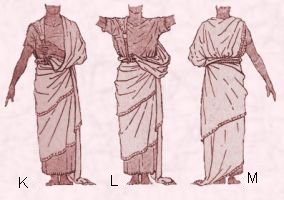
The cord was attached just at E to G.
Then hold G at the right side of the waist in front, whilst throwing the rest of the shawl backwards over the right shoulder.
Edge E to F was then drawn around the back of the neck and formed a sling over the left arm.
To finish draping, the edge E to F was passed around the waist towards the right, under the right elbow, then on around the back until it reached about 6 inches in front of the left side waist. The remainder of the fabric swathe was folded underneath as seen in the drawing. Finally a cord was tied around the waist to keep the draped shawl firmly in position. 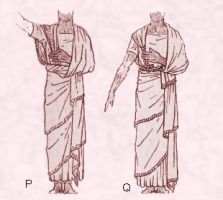
The pictures right also show if cord E to G is pulled down so that E touches the waist, then both the shoulders will be covered by the fabric. Figure K is the most usual way to arrange the shawl compared to L, but minor adjustments will create the different looks. Model M is the back view.
Version P
Model P looks a little more like the costume plate of King Assur-nasir-pal above left. The costume pattern is based on a small statue of that King in the British Museum, which uses a simple under tunic plus two shawls - a square shawl and a half circle shawl.
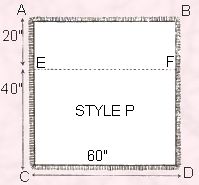 First the wearer must wear a tunic foundation.
First the wearer must wear a tunic foundation. - Next use the Square Shawl
- The square shawl must measure 60" by 60" as shown in the diagram.
Fold about one third of the square shawl over and outwards.
Tie a waist cord on the top of the tunic. Now tuck the corner of the shawl at F deeply into the waist cord at the left side. - Next draw the folded shawl tightly around the body to the front. Take it around again across the back of the waist until the left side is reached once more.
- Now double about 6 inches of the square shawl inwards and tuck into the waist cord.
- The semi circular shawl.
- Use the semi circular shawl edge G to H, and attach the cord at the end, to another waist cord and throw backwards over the right shoulder.
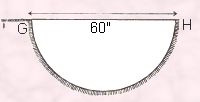 Arrange as a sling over the arm as before in version K above.
Arrange as a sling over the arm as before in version K above.- The corner H of the semi circular shawl hangs in front about 8 inches towards the left and below the waist.
- Over this shawl the second waist cord should be tied very tightly to keep everything in position.
- Further decoration could be added by using jewellery or other accessories. Tassels like these below were typical of decorative finish and would be easy to add to theatrical costumes.

Female Assyrian Dress & an Assyrian Queen
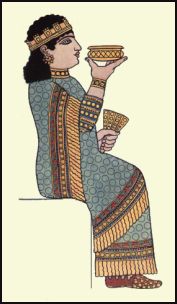
The fringed shawl measure 50" x 80". The instructions to wear this style effectively, suggest first placing one corner of the shawl under the left armpit. Then the shawl should be drawn across the back under the right armpit, wrapping it once around the body.
Right - The Assyrian working woman of about 700 B.C. wears a long tunic with a long fringed shawl.
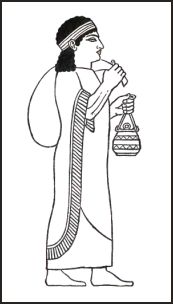
Then it should be drawn across the back and up over the right shoulder, so that a corner of the fringed shawl hangs down in front of the right shoulder.
Left - Colour Plate of Assyrian Queen
This woman is the Queen of King Assur-bani-pal who ruled in the seventh century B.C.
She wears a tunic like the earlier king, but her tunic has longer sleeves. Her shawl would be 50" by 130" and was wrapped once around her lower body, covering the lower part of her tunic and then wound up and around her upper body with the shawl draped over her shoulder.
Observe how each woman wears her hair decoration. The Queen appears to wear a precious metal tiara and the ordinary woman wears a woven headband.
The Hunter
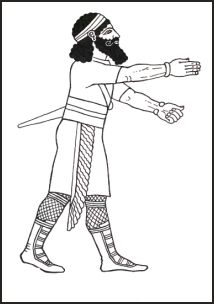
Right - The drapery on this Assyrian ensemble is worn in a different manner. The fringed shawl has been passed around the waist and then taken over the shoulder, with the excess hanging loosely at the back.
Left - This Assyrian hunter wears a shorter tunic and his shawl wrapped around the body is only fringed on the ends.

Tunics could be long or short dependant on era and activity.
By manipulating various types of shawls and rearranging the drapery various looks can be achieved.
Fancy Dress Point
If you are considering wearing Assyrian costume for theatrical or fancy dress reasons, you may well find that a search on EBay for cashmere, will reveal some suitable long pashmina style wraps or shawls from Nepal or Mongolia. These will often be suitable for your costuming purposes.
Bear in mind the typical colours mentioned above when making such a purchase.
Source
This page contains some costume plates sourced from the book Ancient Egyptian, Assyrian and Persian Costumes & Decorations by Mary G. Houston and Florence S. Hornblower. The book was published by A & C. Black of London in 1920.
F. S. Hornblower coloured both the figures and Decorative Ornament plates where colour was needed.
Page Added 24 November 2007. Ref. P664
You have been reading a costume history article by Pauline Weston Thomas at www.fashion-era.com ©
